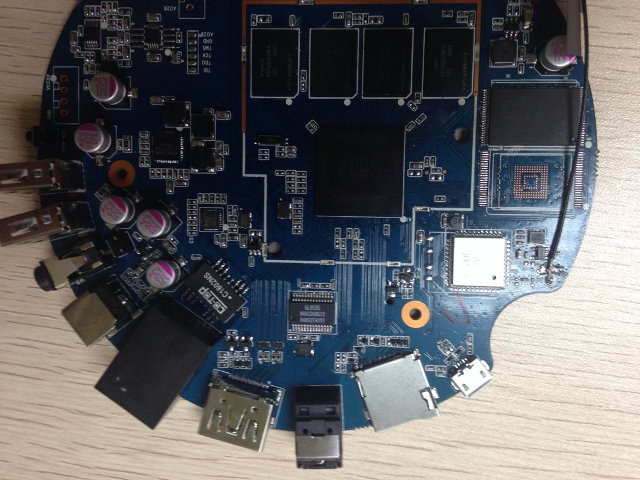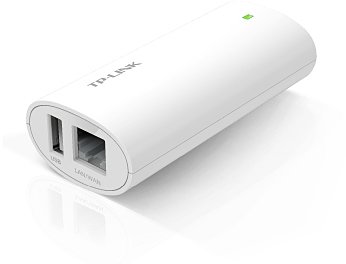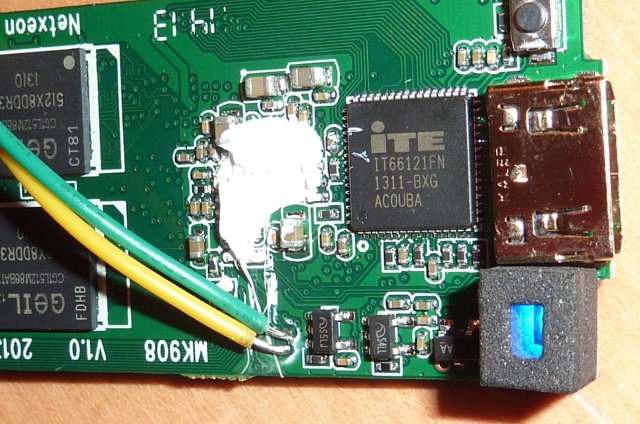AMLogic S802 Android TV Boxes are currently available for pre-order, and are expected to ship by the end of the month. Last time I wrote Tronsmort Vega S89 and Eny ES8 featuring the latest quad core SoC from AMLogic. Geekbuying currently has test samples for both Vega S89 and M8 (similar to ES8), has open them, and taken some pictures of the boards. The good news, if you want to tinker, is that both of them appear to give relatively access to the UART port. Tronsmart Vega S89 Board There are two models: Vega S89 and Vega S89 Elite. The former is the high-end version with dual band Wi-Fi (2.4/5.0GHz) and 16 GB flash, and the latter only supports 2.4 GHz Wi-Fi and comes with 8GB flash. Price: $120 and $105. The serial port appears to be on the left side of the board (TBC), just above the two USB […]
How to Install XBMC on D-Link Boxee Box
D-Link Boxee Box is a Linux based media player powered by Intel Atom CE4100 processor that became available in 2010, and features a dual sided RF remote / QWERTY keyboard that probably inspired many of the air mouse that are available today. The box features many of the ports and connectors that are available on most Android STB today, namely an HDMI port, an optical S/PDIF) out, a stereo analog audio out, Ethernet and 802.11n Wi-Fi, two USB ports, and an SD card slot. Many people however got disappointed with the firmware at launch time, and even if subsequent firmware updates have improved the user experience, some people have considered it was worth the effort to port XBMC to the device. Myles McNamara wrote the instructions to install XBMC on D-Link Boxee Box. I’ll summarize the steps below, and it appears to be relatively easy. Installing Boxee+Hacks to gain root […]
Google Chromecast Gets a Custom ROM: PwnedCast
If you’ve got a ChromeCast, and are disappointed by its limited features, XDA member ddggttff3 has released a custom ROM for the device based on the 13300 stock image. It is rooted, has its own OTA system, and features a dedicated recovery and a custom kernel in order to enhance the user experience. Main features: Root SSH/Telnet Access Uses DHCP DNS Servers Google OTA’s Disabled Custom Boot Image PwnedCast OTA Update Engine! PwnedCast Recovery Image, based on FlashCast V1.1.1 KyoCast Built In! Currently the most interesting feature is the addition of KyoCast which provides access to services like AOL, HBO, Post, Rev3, and Songza. But more work and features are certainly on the way. If you want to give it a try, download the image, and flash it as follows: Setup and Install FlashCast V1.1.1 on a USB Drive in Windows or Linux. Don’t use another FlashCast version, or it […]
Binwalk Utility Helps You Analyze and Reverse-Engineer Firmware Files
Binwalk is a “firmware analysis tool designed for analyzing, reverse engineering and extracting data contained in firmware images”. This tool written in python supports Linux, and somewhat Mac OS X, can scan firmware files for files signature, and can be useful for hacking firmware files, and finding hidden information. Let’s install binwalk first. It’s very easy in a Debian or Ubuntu machine, as you just have to download the package, and run a script for installation:
|
1 2 3 4 |
wget https://binwalk.googlecode.com/files/binwalk-1.2.2-1.tar.gz tar xzvf binwalk-1.2.2-1.tar.gz cd binwalk-1.2.2-1/src sudo ./debian_quick_install.sh |
If you have another Linux ditributions, it’s just a little more complicated. You still need to download and extract the release package as above, but you’ll have to install the following package depending on the features your need: Minimal installation – python 2.6 or greater, and python-magic To generate entropy plot graphs – python-matplotlib For automated extraction: Packages – mtd-utils zlib1g-dev liblzma-dev gzip bzip2 tar unrar arj p7zip p7zip-full openjdk-6-jdk Build and install […]
$27 TP-LINK TL-MR10U is an Hackable OpenWRT Wi-Fi Router with a Power Bank
TP-Link WR703N is a cheap 802.11 b/g/n router (you can now get it for about $20) that can easily be hacked to run openWRT and for example, act as an home automation gateway, printer server and more. But if you need a battery powered router for your application, TP-Link TL-MR10U, based on similar hardware as TL-703WR, should be a better match as it comes with a 2600 mAh battery, and costs just about $27 on DealExtreme. Here are the specifications of the device: CPU – Atheros AR9331 CPU @ 400Mhz System Memory – 32MB RAM Storage – 4 MB Flash Connectivity: 10/100 Mbit Ethernet port 802.11 b/g/n 150Mbps 3G support via external USB dongle USB – USB 2.0 port + micro-USB port for power Misc – Serial port access Dimensions – 91mm x 43mm x 25.85mm(L x W x H) The device comes with a microUSB cable and a user’s […]
Developers Are Working on Chromecast Functionality From Any Android Apps via Any Android Devices
If you don’t just come back from (too long) holidays, you should know Google has released the Chromecast, a $35 HDMI TV Stick that uses a protocol called DIAL to let users stream online videos on the TV via your mobile device or mirror your Chrome browser on the TV. However, there are currently quite a few limitations. It can only be used with apps specifically designed for Chromecast (e.g. YouTube, Netflix,…), and Chromecast is the only available receiver, and can only be purchased in the US. Luckily these may not be an issue soon… Koushik Dutta (Kouch) has taken care of the first issue by modifying Cyanogenmod to allow any video or audio app to stream the media files via the TV, using Android notifications. Perfect. Moving to the second issue. If you don’t live in the US, you’re still stuck, and if you do live in the US, […]
Hacking MK908 mini PC for Serial Console Access
Thanks to Omegamoon (and this brother) we already have instructions to connect the UART pins on MK808 in order to access the serial console. He’s done it again with MK908 mini PC featuring Rockchip RK3188. Tx and Rx pads are located on the RAM chips side, and he has connected the green wire to Tx (Going to Rx on TTL debug board), and a yellow wire to Rx (Tx on debug TTL board). A ground pad is available on the other side of the board. Since I got a sample for review from Geekbuying, I decided to give a try myself. The pad are quite small, so this may require patience, but it’s perfectly feasible. I wanted to keep the device closed, so I passed the wires through the ventilation holes (enlarging them a bit with a precision screwdriver), put back the main heatsink on RK3188, and reassembled the enclosure. […]
Zyxel NSA310 / NSA320 Hackable Network Access Storages Run Debian Linux
Yesterday, we saw how to make a NAS enclosure for the Cubieboard, but DesertF0x commented “Better take a NSA-310 or NSA-320. It is easy to install Debian and it has Gigabit!”, and I decided to have a look. The 2 devices appear to have been released at the end of 2011, and are powered by a Marvell ARMv5 compatible processor. Many NAS are expensive kits, but NSA310 (1 bay) is currently available for $88.50 and NSA320 (2 bays) for $95.34 on Amazon, which is just a little cheaper than the DIY Cubieboard NAS solution (~100 USD). Price looks attractive, now let’s have a look at some technical details, and instructions to install Debian. Both NAS more or less share the same hardware specifications except for a few details: Processor – Marvell Kirkwood 88f6281 ARMV5-TE compliant processor @ 1.2 GHz (Hardware datasheet) System Memory – 256 MB (NAS310) or 512 MB […]










